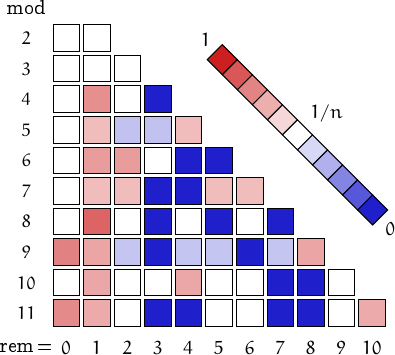The subfactorials up to 1015 :
1, 2, 9, 44, 265, 1854, 14833, 133496, 1334961, 14684570, 176214841, 2290792932, 32071101049, 481066515734, 7697064251745, 130850092279664.
Distribution of the remainders when the numbers in this family are divided by n=2, 3,..., 11. (I took into account 10000 values, from 1 to 1.047⋅1035663).
| n\r | 0 | 1 | |||||||||
|---|---|---|---|---|---|---|---|---|---|---|---|
| 2 | 5000 | 5000 | 2 | ||||||||
| 3 | 3333 | 3333 | 3334 | 3 | |||||||
| 4 | 2500 | 5000 | 2500 | 0 | 4 | ||||||
| 5 | 2000 | 3000 | 1000 | 1000 | 3000 | 5 | |||||
| 6 | 1666 | 3333 | 3334 | 1667 | 0 | 0 | 6 | ||||
| 7 | 1428 | 2143 | 2145 | 0 | 0 | 2142 | 2142 | 7 | |||
| 8 | 1250 | 5000 | 1250 | 0 | 1250 | 0 | 1250 | 0 | 8 | ||
| 9 | 3333 | 2222 | 556 | 0 | 556 | 555 | 0 | 555 | 2223 | 9 | |
| 10 | 1000 | 2000 | 1000 | 1000 | 2000 | 1000 | 1000 | 0 | 0 | 1000 | 10 |
| 11 | 2727 | 1819 | 909 | 0 | 0 | 909 | 909 | 0 | 0 | 909 | 1818 |
A pictorial representation of the table above

Imagine to divide the members of this family by a number n and compute the remainders. Should they be uniformly distributed, each remainder from 0 to n-1 would be obtained in about (1/n)-th of the cases. This outcome is represented by a white square. Reddish (resp. bluish) squares represent remainders which appear more (resp. less) frequently than 1/n.
e-mail: info -at- numbersaplenty.com • Privacy notice • engine limits